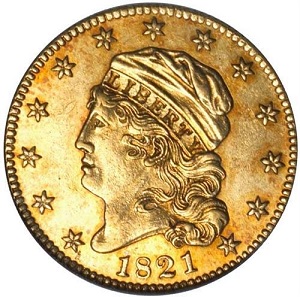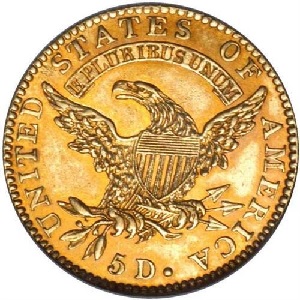1821 Capped Head $5 Half Eagle
The Mint Act of 1792 adopted a bimetallic standard, setting a rigid 15:1 ratio between silver and gold. However, the law had no jurisdiction outside the United States. International markets reacted to huge silver discoveries in Latin America, driving the ratio to 16:1 and higher in other countries during the early decades of the 19th century.(1)
Bullion profiteers saw an opportunity in the ratio discrepancy. With 15 ounces of silver, a speculator could obtain one ounce of U.S. gold, which in turn, could buy 16 ounces of silver in Europe. With more silver in his pocket than before, the speculator returned to the U.S. and repeated the process as many times as possible.
This scenario seriously depleted the supply of circulating U.S. gold coins. Congressman Ezekiel Whitman of Massachusetts had this to say in 1821: "There have been coined at the Mint of the United States nearly $6,000,000 in gold. It is doubtful whether any considerable portion of it can at this time be found within the United States."(2)
As an added incentive to exporters, the Mint incidentally provided free assay services and preparation (i.e., coining) of the gold before being sent overseas.
Foreign governments also took advantage of the situation by acquiring overweight U.S. gold coins and converting them to their national coinage, consisting of lesser gold weight. Reportedly, on a single day in 1831, 40,000 U.S. half eagles were melted in Paris.(3)
The great majority of U.S. gold coinage issued from the 1790’s and into the 1830’s succumbed to the same fiery demise until Congress passed a law on June 28, 1834, to reduce the gold content of American coins.(4)
The Capped Head half eagle type was released starting in 1813 and ran until 1834, but as we know, few of them reached America’s streets before heading across the Atlantic.
The 1821 is one of the rarest dates in the very elusive Capped Head series. Mint records indicate 34,631 half eagles were struck in 1821, but researcher John Dannreuther believes many of that mintage were dated 1820. In the early years of the resource-strapped Mint, still-serviceable but out of date dies were sometimes used in later years.(5)
There are two die varieties for the 1821 half eagle, known as BD-1 and BD-2, distinguishable by the orientation of Star 6 and positioning of Star 13. The estimated number of BD-1 survivors is 12 to 15 examples, but only 3 to 5 of the BD-2.(6)
Fascinating Fact: The finest known 1821 half eagle is a PF-65 specimen with cameo appearance. In 1885, it was purchased by W. Elliot Woodward for $17.00. The same exact coin sold in September 2022 for $4.62 million.(7)
The 1821 half eagle is truly one of the legendary coins in United States numismatics. Whenever an example hits the auction block, everyone involved in the coin business watches the spirited bidding carefully. With a very long history of incredible price advancements, lucky owners of the 1821 half eagle should be confident of reselling at a much higher price when that time comes.
| Estimated survivors in all grades: 19 ?
The survivor estimate from PCGS represents an average of one or more experts' opinions as to how many examples survive of a particular coin in all grades. Survival estimates include coins that are raw, certified by PCGS, and certified by other grading services. Learn more at PCGS. |
| PCGS Rarity Scale: 9.1 ?
The 'PCGS CoinFacts Rarity Scale' assesses the relative rarity of all U.S. coins, based on estimated surviving examples. The scale runs from 1.0 to 10.0. The higher the number, the rarer the coin.
Learn more at PCGS. |
| Click HERE to check for availability on eBay** |
Preview of eBay selection (don't expect to find this rarity for sale very often -- also click HERE link above):
 |
 |
| Trendline Avg = 37.67 | BEST |
Historic Value Trend Charts:
| Last updated 8-7-24 | Return to Key Date Coin List | |
| Compare to Common Date Coin of Same Type | ||
|
|
||
| Download Charts to Your Computer | ||
Sources
1. Heritage Auctions. 1821 $5 BD-1. Jan 2015 Auction.
2. Stack's Bowers Galleries. 1821 Capped Head Half Eagle. BD-1. May 2016 Auction.
3. Heritage Auctions. 1821 $5 BD-1. Jan 2015 Auction.
4. Stack's Bowers Galleries. 1821 Capped Head Half Eagle. BD-1. Aug 2011 Auction.
5. Heritage Auctions. 1821 $5 BD-1. Jan 2015 Auction.
6. NGC. 1821 $5 MS.
7. Heritage Auctions. 1821 $5 BD-1, PR65 Cameo. Sep 2022 Auction.
**Many very fine coin dealers sell on eBay. At any point in time, there may be over one million search results for United States coins. This includes quite a few of the recommendations on our Key Date Coin List.
If you’re thinking about purchasing a rare coin, eBay is certainly worth a look. For your convenience, the links from this site to eBay are coded to bring up only coins certified by PCGS and NGC.
As is always, always the case, never buy a valuable coin from a seller whose trustworthiness cannot be verified. Learn more about this at our chapter Best Places to Buy Coins, which also has a section on doing business on eBay.
In the interest of full disclosure, Rare Coins 101 receives a small commission anytime someone connects to eBay from this site and purchases something.
Coin Images by Stack's Bowers Galleries.


